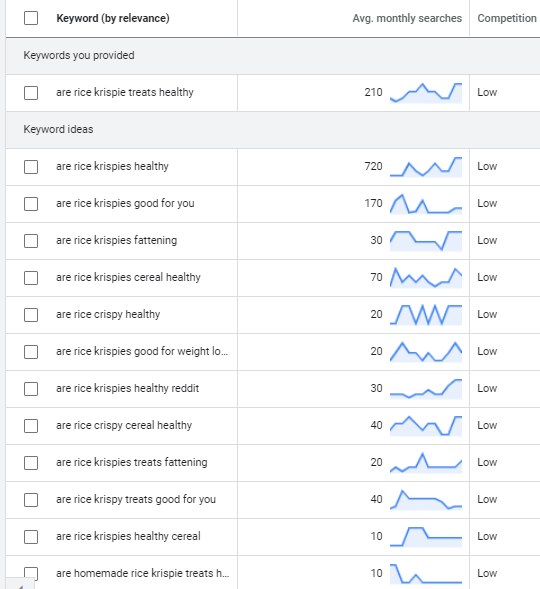Explore the Blog
Editorial Newsletters: Does Your Brand Actually Need One?
Popular reads
The Problem With Using AI For Content Writing in 2025
Recent Searches
Content Marketing, Copywriting, Email Marketing, Expert Interviews, Website Copywriting, eCommerce Marketing, B2B Marketing
Get the inside scoop on digital marketing for food and beauty brands
How to Create Content that Builds Your SEO

Writing SEO-Friendly Blog Posts
Creating SEO optimized content is kinda like going to the dentist every six months. You know you should do it, but it’s easy to postpone, and even thinking about it can be painful.
But SEO-friendly posts don’t have to be a hassle. I’ve streamlined my own process so it takes less time, and yields results.
Remember SEO won’t bring in big sales overnight. It’s a slow and steady process. You’ll likely find posts you wrote years ago are the ones that bring you the most traffic over time.
We all know we need keywords, or KWs as I’ll call them from here on out, for SEO. But before making an arbitrary list of ideal KWs, you’ll want to evaluate which search terms are bringing in traffic, and ensure that A) they’re a good match for what you’re actually selling, and B) your landing pages echo those search terms and match the exact message your visitors are expecting.
Here’s an example: If you sell sugar-free marshmallow rice bars, you’ll likely want to attached people who love traditional Rice Krispie bars and can’t have, or don’t want to have any sugar. That’s a pretty niche audience. Here’s how you can approach building your top-of-funnel content;
1. Set up Google Search Console and find out what searches are bringing people to your site right now. You might discover people are finding you when they Google terms including:
-
“Marshmallow Dream Bar”
This isn’t a very good term for you, because people typing this in probably want to find Starbucks version of a ready made Rice Krispie Treat. Look at the bounce rates and time on site for this term. If there’s a high bounce rate, look at ways to take out words and phrases like “dream” and “dream bar’ from your site. There’s no point in attracting traffic that’s not a good match, because Google will punish those high bounce rates.
-
“Are Rice Krispie Bars Healthy?”
Now we’re onto something, because this question likely represents someone who loves Rice Krispie bars, but is concerned about health – a pretty close match to your ideal customer! This could be a great topic for your content.
2. Find your exact KWs – in this case “Are Rice Krispie Bars Healthy?”
Use your Keyword Planner tool in GoogleAds to select exact KWs that are getting traction. Google Ads is free – and while you’ll see more detailed search volume numbers if you’re actually running ads, you don’t need to have any ads in order to benefit from this tool!
You’ll see something like this:

When you see this, you’re checking for that search volume number, whether it’s trending up or down, and the competition tag.
You might be tempted by “are rice krispies healthy” because it has 720 searches a month and low competition. It’s a good choice, right? No, I don’t think so, because these searchers only care about the cereal, not the sweet sticky bars. “are rice krispie treats healthy” looks like a great KW, though – it’s got 210 searches per month and low competition.
Don’t bother going for the keywords that have a ton of traffic and high competition. It’s better to start with mid-range KWs, and once you start ranking for those, move up to more difficult ones. You really want to be on the first page of results for your designated KWs.
Be sure to look for related KWs using off brand names and terms like “marshmallow bars” too. This process can be time-consuming, but it’s worth it.
You’ll see some people choosing around ten KWs for each post. But you really only get to emphasize one to three of those, so I keep it simple by choosing one primary, one secondary, and one tertiary KW for each post. And if they’re aren’t three great ones, don’t worry – you can build your post around one strong KW.
3. Write the piece.
Now that you’re writing the piece you’ll want to be sure and use your primary KW in a few places.
It used to be that content mills turned out blog posts that read something like this:
Are Rice Krispie Treats Healthy?
Rice Krispie Treats are delicious, but we asked ourselves “are Rice Krispie treats healthy?” Here’s what we found when we tried to answer whether Rice Krispie treats are healthy:
– Rice is healthy
The grain used to make Rice Krispie Treats is indeed healthy, so that’s our first part of the answer to are Rice Krispie Treats healthy
Yuck. Thankfully SEO has moved beyond dumb keyword stuffing. Now, you’ll be rewarded for writing rich, user-oriented copy. The catch is – it must be relevant to the search term. Using a KW in your Title and H1, and then taking the article in a slightly different direction is just as bad as stuffing it full of robotic phrases.
Writing for your reader means writing good content, on the topic they actually want to read about.
In copywriting, we call this “message matching”.
SEO is just as much about what you don’t see on the page, as what you do. Before you publish, make sure you’ve optimized your SEO page elements, including:
-
Page title
-
Make this crystal clear, put the focus on your primary KW, and remember that your title will cut off in Google search results after about 55 characters.
-
-
Your meta description
-
Another place to focus on your primary, as well as your secondary and tertiary keywords. But don’t make this a KW-stuffed list – make it readable, and remember, this may be the blurb that inspires someone to click your link! So keep it interesting.
-
-
Your H1 title copy
-
Your main title on the page should be formatted as an H1 so Google knows it’s your title. This little line has a tricky role, because it has to hook people into reading further, meaning it has to be engaging, not boring. BUT it should also include your primary key phrases.
-
Google reads your pages like a human… (well, kinda…), which means their little robot crawlers start at the top of the page and read down. So your intro paragraph is another great place to make sure you’re covering the main topic of your page.
-
-
Your image alt-tags as appropriate
-
Alt-image tags should always be used. And you should use them to boost the accessibility of your site. However, if you’re images are of relevant things to your page topic, they can also help boost your SEO when you use strategic wording in them.
-
Once you’re created your SEO-optimized piece, it’s time to share it! Remember, it’ll take Google time to find and start sending people to your page on its own. And part of its formula involves highlighting pages that are already popular. So the more you share your site, and the more (real, not scammy) links to it you get, the better your page will perform on in search results.
If you’re interested in getting a custom content strategy for your brand, send me a note at anna@annakbradshaw.com.


Top 2025 Content Marketing Trends
This year, I’m seeing three big trends come to the forefront of content marketing.
a must-read
Follow along on instagram
Not Ready to Work Together Quite Yet?
Stay in touch with the Your Brand Editor newsletter 📬
Anna Bradshaw is a copywriter and content strategist based outside Raleigh, North Carolina. She focuses on creating brand marketing campaigns, evergreen SEO content plans, and website copy that converts.